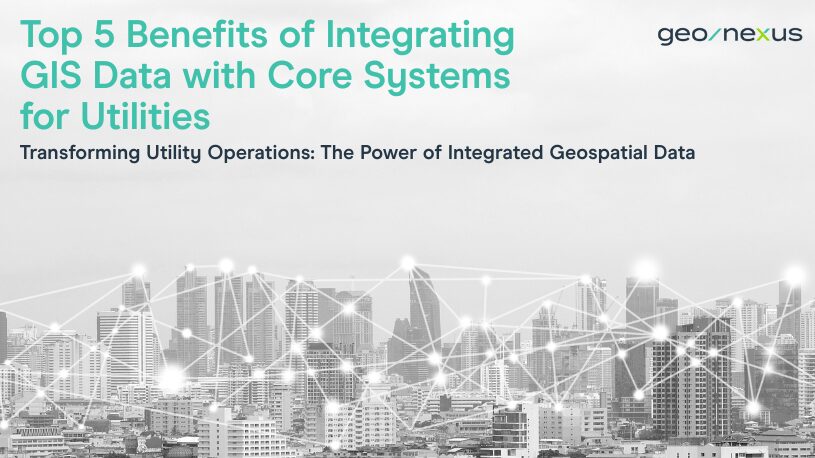September 13, 2025
Integrating Geographic Information System (GIS) data with core utility systems—such as asset management, work management, SCADA, and customer information systems—delivers measurable value for electric, gas, water, and wastewater utilities. Here’s how a connected approach drives operational excellence across the industry:
Enhanced Asset Management and Operational Efficiency
A connected system transforms asset management by serving as a single source of truth for all infrastructure data. Utilities benefit from:
- Centralized Asset Visibility: Integration creates an authoritative system of record, ensuring all departments access the same, up-to-date information about asset locations, conditions, and maintenance histories. This reduces duplication, streamlines onboarding, and improves safety by making it easier to locate and understand assets in the field.
- Optimized Maintenance Planning: By linking GIS with maintenance management systems, utilities can automate maintenance schedules, track inspections, and prioritize repairs based on real-time asset conditions. This proactive approach extends asset lifespans and reduces unplanned outages.
- Resource Efficiency: Integration enables better resource allocation, reducing unnecessary site visits and optimizing crew assignments, which directly lowers operational costs.
Example:
A large utility integrated its GIS with asset management and maintenance planning systems, resulting in faster response times, reduced maintenance backlog, and significant cost savings through optimized resource deployment.
For a deeper dive into how utilities are approaching GIS data integration in 2025, see GIS Data Integration in Utilities: What’s New in 2025?
Improved Decision-Making with Holistic, Real-Time Data
When GIS is connected with other business systems, utilities gain a comprehensive, real-time view of their operations:
- Data-Driven Planning: Integrated data supports more accurate modeling, forecasting, and scenario analysis for everything from capital planning to emergency response. Managers can analyze spatial and operational data together, leading to smarter, faster decisions.
- Proactive Risk Management: Overlaying asset data with environmental or hazard information enables utilities to identify vulnerabilities, prioritize investments, and mitigate risks before they escalate.
- Efficient Resource Allocation: Real-time data integration ensures that budgets and resources are focused where they will have the most impact, minimizing waste and maximizing ROI.
Example:
A regional utility used integrated GIS and operational data to identify flood-prone infrastructure, enabling targeted upgrades and reducing service disruptions during severe weather events.
Faster Response and Greater Reliability in Field Operations
Connecting GIS with field management and mobile systems transforms field operations:
- Real-Time Data for Crews: Field teams access the latest maps, asset data, and work orders on mobile devices, even offline. This reduces errors, improves situational awareness, and ensures crews are dispatched to the right locations with the right information.
- Streamlined Workflows: Integration allows for digital work order management, real-time status updates, and automated reporting from the field, eliminating paperwork and manual data entry.
- Enhanced Safety and Productivity: Accurate, accessible data helps crews avoid hazards, reduces travel time through optimized routing, and boosts first-time fix rates.
Example:
A utility implemented mobile GIS integrated with work management systems, resulting in faster outage restoration, improved data quality, and higher customer satisfaction.
Stronger Regulatory Compliance and Risk Management
Integrated GIS supports regulatory compliance and risk mitigation by:
- Automated Data Collection: Digital integration ensures that inspection, maintenance, and incident data are automatically captured and stored, supporting audit trails and compliance reporting.
- Decision Support: Utilities can use GIS-integrated data to develop rehabilitation and control plans for infrastructure, such as sewer systems, in response to regulatory mandates.
- Reduced Administrative Burden: Paperless workflows save staff time, reduce errors, and make it easier to demonstrate compliance during audits.
Example:
A city utility integrated its field inspection data with GIS, enabling automated compliance tracking and streamlined reporting for sewer overflow regulations.
Superior Customer Service and Stakeholder Engagement
A connected data environment directly improves service delivery and stakeholder communication:
- Faster, More Accurate Service: Customer service reps can view integrated maps showing both customer locations and utility assets, enabling quicker, more accurate dispatching and status updates.
- Reduced Service Errors: Integration reduces misdirected or redundant service calls, improving first-contact resolution and customer satisfaction.
- Transparent Communication: Utilities can provide customers and stakeholders with real-time outage maps, restoration timelines, and proactive notifications, building trust and engagement.
Example:
A utility integrated GIS with its customer service and field systems, leading to double-digit reductions in misdirected service calls and faster, clearer communication with customers during outages.
How Geonexus Empowers Utilities
Geonexus is a leading integration platform trusted by utilities worldwide to connect GIS with enterprise systems. The Geonexus Integration Platform is a no-code, out-of-the-box solution that ensures data integrity, accuracy, and timeliness—driving efficiency, reducing costs, and accelerating digital transformation for asset-intensive organizations. With proven connectors for Esri ArcGIS, IBM Maximo, SAP, Oracle, and more, Geonexus eliminates the complexity of integration, allowing utilities to focus on leveraging their data for innovation and operational excellence.
Looking Ahead: Key Considerations
As utilities modernize, integrating GIS with core systems lays the groundwork for future innovation. Focusing on data quality, cybersecurity, scalability, and user adoption will help utilities maximize their investment, adapt to new challenges, and deliver even greater value to customers and stakeholders.
While integration can be complex, platforms like Geonexus make connecting GIS and business systems easier, more reliable, and scalable—helping utilities achieve these benefits with less risk and effort.
To learn how Geonexus makes integration easier and more reliable for utilities, visit our system integration blog archive.
Ready to see how seamless integration can transform your utility’s operations?
Connect with Geonexus today to discuss your integration needs or request a personalized demo. Contact us through our website form and a member of our team will reach out to help you get started.
